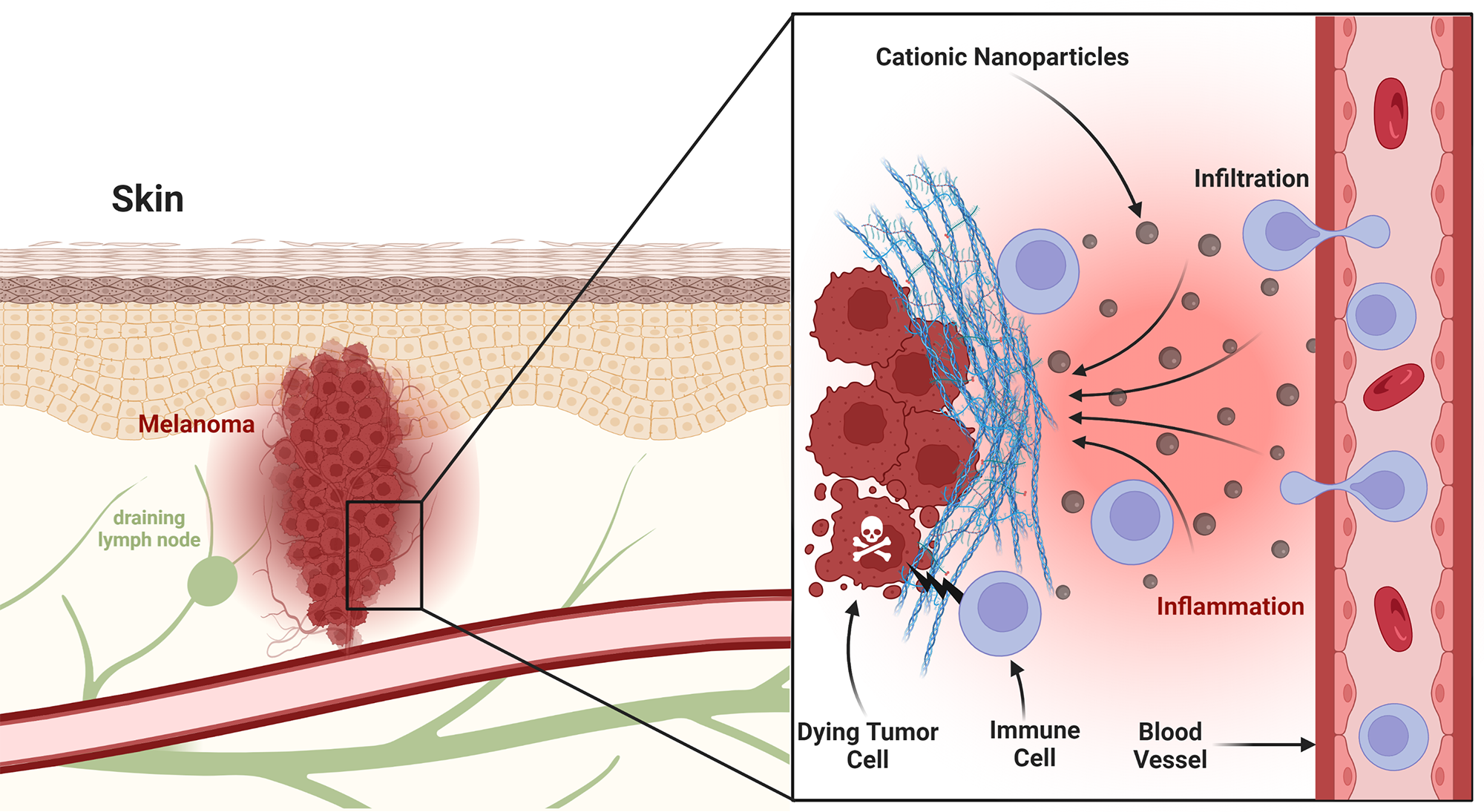Cancers can survive and spread in a variety of ways in humans. Cells and tumors engage in crafty means to deflect, trick, and evade detection by the body's immune system.
 Pharmaceutical scientists at the University of Iowa have found that a charged nanoparticle-vaccine combination eliminated tumors or extended life span in mice with melanoma tumors. The image shows a melanoma tumor with blood and lymphatic vessels. The magnified portion shows how the charged nanoparticles stimulate immune cells to locate and fight the tumor. Image Credit: Iowa State University
Pharmaceutical scientists at the University of Iowa have found that a charged nanoparticle-vaccine combination eliminated tumors or extended life span in mice with melanoma tumors. The image shows a melanoma tumor with blood and lymphatic vessels. The magnified portion shows how the charged nanoparticles stimulate immune cells to locate and fight the tumor. Image Credit: Iowa State University
For instance, consider how they resist anti-cancer vaccines. Cancer cells present in the body, be it singularly or consolidated, cloak themselves via chemical secretions to stay camouflaged from agents in the vaccines that would otherwise activate an all-out attack from the body’s immune system.
The fact that the immune system largely cannot “see” cancer is a significant reason why cancer treatments resort to random warfare that kills cancerous and healthy cells alike.
At the University of Iowa, pharmaceutical researchers might have found a new strategy to overcome the ingenious defenses of cancer. In a new study, the scientists found that charged nanoparticles integrated with a vaccine were effective in removing tumors or prolonging the life span in cancerous mice.
The new method seems to be appealing, and the scientists contend that the nanoparticle could be mass manufactured, stored at room temperature, and further administered by general physicians to treat a range of cancers.
This could be an off-the-shelf, stable formulation that could be available as a powder.
Ali Salem, Study Corresponding Author, Lyle and Sharon Bighley Endowed Chair and Professor, Pharmaceutical Sciences, College of Pharmacy, University of Iowa
The charged nanoparticles — spheres varying in diameter from 100 to 160 nm made in Salem’s laboratory — were injected near melanoma tumors in mice. The nanoparticles serve as a beacon of sorts, enabling melanoma-fighting cells activated by the adenovirus vaccine to spot the tumor and defeat its defenses.
In one set of experiments that involved nine mice given the nanoparticle-adenovirus vaccine formula, five mice became cancer free, while the other four lved for over 100 days — over three times longer compared to those given only the vaccine and five times longer than those given nothing at all.
It’s a new approach to treating cancer and making vaccines work better. Historically, vaccines haven’t had the level of translational success that they have promise for. This approach might finally realize the promise of vaccines to treat cancer.
Ali Salem, Study Corresponding Author, Lyle and Sharon Bighley Endowed Chair and Professor, Pharmaceutical Sciences, College of Pharmacy, University of Iowa
The adenovirus vaccine jump-starts the cancer-fighting operation of the body by instructing a family of immune cells, known as cytotoxic T lymphocyte cells, to spread out on tumor search-and-destroy missions.
However, tumors tend to secrete chemical signals to make themselves appear nonthreatening and thus hugely evade detection. The charged nanoparticles, while injected next to a tumor, make an inflammatory response, like setting a house on fire. The T cells, circulating around, observe the flames and rush to the site.
The cationic nanoparticles create a localized inflammation at the tumor site. It sends up a signal, ‘Hey, come over here, we have a situation here that needs to be taken care of.’ The nanoparticles are a critical addition to help the vaccine be effective.
Emad Wafa, Study Co-Author and Postdoctoral Researcher, College of Pharmacy, University of Iowa
Other studies have previously illustrated the success of utilizing a combination of an adjuvant — a vaccine booster developed to stimulate a powerful immune response — and a vaccine to spot and eradicate tumors.
In one such study, headed by Sean Geary, an assistant research scientist in Salem’s lab and a co-author of this study, scientists injected an adjuvant known as CpG directly into mouse tumors, which was integrated with an adenovirus vaccine to combat tumors in mice. However, CpG did not function as effectively in that study and is not as simple to mass manufacture.
“We have a synthetic agent that’s more cost-effective, it’s easier to manufacture, it’s more stable, and it would be easier for a physician to learn and use it, versus a biologically based agent. It’s a conceptually different approach,” stated Salem, who has studied vaccines for 23 years.
The study outcomes were reported online in the journal Science Advances on July 20th, 2022.
The co-authors of the study include Rasheid Smith, who earned his doctorate in pharmaceutical sciences from Iowa and is presently working as a senior scientist at the pharmaceutical firm Zoetis; Kareem Ebeid, who earned his doctorate in pharmaceutical sciences from Iowa; and Suhaila O. Alhaj-Suliman, who earned her doctorate in pharmaceutical sciences from Iowa this month.
This study was financially supported by the National Cancer Institute, a branch of the National Institutes of Health, and the Leukemia & Lymphoma Society.
Journal Reference:
Smith, R., et al. (2022) Cationic nanoparticles enhance T cell tumor infiltration and antitumor immune responses to a melanoma vaccine. Science Advances. doi.org/10.1126/sciadv.abk3150.